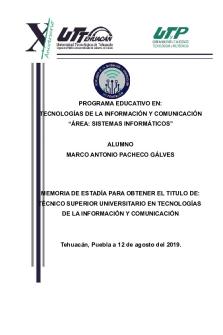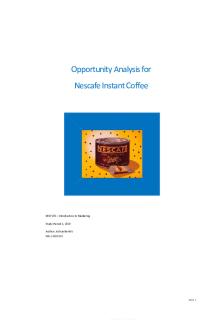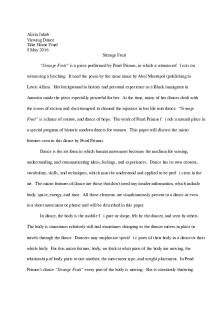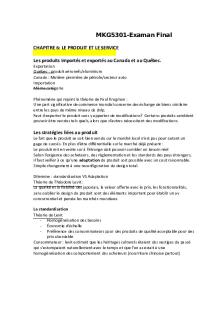Synoptic Carlsberg Final PDF

| Title | Synoptic Carlsberg Final |
|---|---|
| Course | Business and Management Synoptic |
| Institution | Oxford Brookes University |
| Pages | 29 |
| File Size | 1.4 MB |
| File Type | |
| Total Downloads | 91 |
| Total Views | 146 |
Summary
Synoptic final assignment term 1...
Description
U51073 Business and Management Synoptic
Synoptic Case Study of Carlsberg Critically evaluate Carlsberg's business strategy in relation to its current external and competitive environment and Carlsberg's efforts to maintain and develop a shared corporate culture in relation to its global expansionist strategy. Based on your research, give strategic recommendations to Carlsberg to enhance its current and future business success.
Table of Contents Introduction
2
Carlsberg’s Business Strategy Within its External and Competitive Environment Market Environment
2
Macro Environment
2
Micro Environment
3
Asian Market
2
3
Tuborg In Vietnam 3 Russian Market
4
Carlsberg’s Business Strategies
5
Previous Business Strategy 5 Evolution of Carlsberg Current Strategy
5
6
Carlsberg's Maintenance and Development of a Shared Corporate Culture Organisational Culture
6
Organisational Change
7
Carlsberg’s Process of Change Lewin’s Change Model
6
8
8
Unfreeze 8 Change
8
Refreeze 9 The Content of Change
9
Recommendations 9 One Corporate Culture model Russian Market 2018
10
Vietnamese Market 2018
11
Organisational Change
11
9
Conclusion 11 Appendix
14
Reference List 24
1
Introduction Carlsberg are ‘more than just a beer company’ (Carlsberg Group Annual Report, 2016), they’re a worldwide group. ‘In 1847 the first ever Carlsberg brewery was founded’ (Carlsberg Milestones, 2017), since then Carlsberg has grown into the ‘fourth largest brewer in the world, with a portfolio of more than 400 beers, ciders and other beverages’ (Carlsberg Group Annual Report, 2016) including world renown beers such as Tuborg and Kronenbourg 1664. Carlsberg provides jobs for ‘42,062 employees worldwide’ (Carlsberg Group Annual Report, 2016). Carlsberg’s 2016 turnover dropped by 4.9% from 2015, leaving 9.13$bn in turnover and a profit margin of 11.25% (Orbis Company Reports – Carlsberg A/S, 2017). In 2015 Carlsberg’s European market share stood at 13.3% putting them below Heineken, the market leader, which had 17.2% market share (Beer & Cider Industry Profile: Europe, 2016). Carlsberg’s global reach of sales expands through Eastern and Western Europe and parts of Asia such as India, China, Vietnam and Malaysia. Carlsberg’s core values revolve around a strategy called ‘SAIL’22’, which was launched in March 2016 with the intent to strengthen the core business values of the group (Carlsberg Group, 2017). SAIL’22 focuses on four key priorities: Strengthen Core, Position for Growth, Create a Winning Culture and Deliver Value for Shareholders (Carlsberg Group, 2017).
Carlsberg’s Business Strategy Within its External and Competitive Environment Market Environment Macro Environment Carlsberg has grown to become the second largest brewer in Northern and Western European markets, where growth is expected to be stagnant or slightly declining (Company Spotlight: Carlsberg, 2010), despite this, Carlsberg’s beer volumes increased by 33% from 2007 to 2010 (Company Spotlight: Carlsberg, 2010) showing growth even in adverse economic environments. Governments and politicians frequently affect Carlsberg with alcohol laws, such as TV bans on the advertising of any drink with an alcohol content of 1.2% or higher in France (See Appendix 10) (Cozens, 2001). ‘Alcohol consumption is falling across the UK’ (The Drinks Business, 2017) as
2
health-conscious customers are increasing awareness of recommended consumption and what negative consequences this has, therefore lowering beer consumption. This may be linked to veganism rising by 360% in the past ten years and gym membership has soaring by 44% in 2015 (The Drinks Business, 2017). Incorporating CSR has allowed Carlsberg to create a structure for employees to become environmentally conscious and energy saving. This allows Carlsberg to cut costs and have an ethical outlook on their company, which may entice the ethical consumer to buy Carlsberg products. It is evident that the alcohol market is very reactive and full of change that Carlsberg must be able to anticipate for operate efficiently (See Appendix 10). Micro Environment In 2014, BBC News claimed that Carlsberg’s sales in the Russian and Ukrainian markets had declined due to lower beer consumption (BBC News, 2014). Lauren Eads (2014) stated that this problem derived from ‘trade restrictions on food and drink from the West’ implemented by Russia. This resulted in a decline in beer volumes for Carlsberg of 6-7% in the second quarter of the year (See Appendix 4), due to ‘uncertain macroenvironment’ and ‘weak economic development’. Carlsberg must re-evaluate its strategy in these markets to overcome the issues present for continuous growth and retention of its market position. Carlsberg has achieved greater success in India, Sinha (2016) states Carlsberg ‘has more than doubled its market share when rivals have just been able hold their position’, this includes rivals Kingfisher who ‘continues its dominance even after a decade’ as the market leader (Appendix 11). The main challenge is growing their market share and maintaining a strong position which they achieved already. However, this growth must continue to compete effectively, especially as there are many ‘young, growing middle class’ (Davies, 2017) citizens. Asian Market Tuborg in Vietnam The performance of Tuborg in Vietnam has seen rising revenues and profits in the first 6 months of 2017 which increased profitability, even though less beers were sold in volume (Gerard, 2017). Andy Morton (2017) claims that ‘Vietnam is a big market with a large young population’ (See
3
Appendix 2). This makes Vietnam an excellent market to compete in due to high demand from a large young population that are likely to consume beer over other age segments, (See Appendix 3) ‘It’s citizens of legal drinking age, 18 and above, is expected to increase to 72.4 million by 2021’ (Ngoc Chau, 2016). It is important for Carlsberg to focus heavily on their growth to regain lost market share in Asia, as this dropped from 32% in 2013 (Rosenzweig and Scavenius Lang, 2013) to 10% in 2016 (IR Corporate Presentation, 2016). Vietnam possesses an attractive brewery market, with beer demand increasing by 300% since 2002 (Saigoneer, 2017). In addition, the emerging young, middle class are developing sophisticated alcoholic preferences (Saigoneer, 2017). This represents a market which Carlsberg can exploit substantially, through a growing market share, presenting itself as an optimal location for achieving SAIL’22’s strategic objectives. Russian Market Russia, tied with Germany, is the fourth largest beer consuming market worldwide, outputting 5% of the worlds beer volume (Appendix 13). Operating under Baltika Breweries and Carlsberg, both breweries have faced continuous issues in Russia. The Russian ban on 1.5L bottles in August 2017 (Fortune, 2017) resulted in Carlsberg’s rivals aggressively slashing their prices to protect their market share, competitors such as Anheuser-Busch InBev used a Predatory pricing strategy and set low prices to eliminate competitors. Carlsberg decided to preserve their profitability and used price skimming to charge high prices and slowly lower them to appease the market segment. The result was a decline in volume sales for Carlsberg in the Eastern European market, as well as a 5% drop in market share (Fortune, 2017). Referring to Porter’s Diamond Model of the Russian Market (Appendix 8), breweries operating in Russia have plenty of land to build their facilities, Russia has the largest land area in the world, where 10% is used for agricultural purposes (Siani, 2013). This makes expansion easy for Carlsberg, especially since according to the World Health Organisation (2016), Russia was the fourth largest alcohol consumer per capita in 2016. In addition, ‘Baltika has been the no. 1 brewer in the Russian market since 1996 due to its state-of-the-art equipment and application of advanced 4
technologies’ (Carlsberg Group, 2017). Furthermore, Russia’s workforce is highly skilled and educated (See Appendix 9) making the outsourcing of employees unnecessary, therefore saving costs on recruitment. However, Studies show that if the maximum allowed PET container size decreases to 0.5L, demand is expected to decline by 15-20% (Hansen, 2016). This could be detrimental to Carlsberg beer demand will drop substantially, therefore making the Russian market unattractive to operate in resulting in the closure of many breweries. Carlsberg’s Business Strategies Previous Business Strategy Carlsberg’s previous business strategy was built around their original slogan ‘Probably the best beer in the world’, this was changed in 2011 to ‘That calls for a Carlsberg’ (Strategic direction, 2015). Carlsberg’s culture strengthened with communication and cooperation which led to ‘Significant operational improvements, leadership capabilities improved, and structural complexity reduced’ (Strategic direction, 2015). According to UTalk Marketing (2011), the ‘campaign focused on making Carlsberg an asset within the company's brand portfolio’, showing Carlsberg’s objective of growing their brand reputation to attract new customers and increase customer retention. Keeping customers loyal would promote Carlsberg via word of mouth, Buzz Canuck (2007) claims Carlsberg has the best word of mouth promotion worldwide. Carlsberg’s slogan change was an excellent opportunity to re-evaluate their business strategy and to promote themselves along with institutionalising a new way of operating as a business to improve efficiency. Evolution of Carlsberg Carlsberg became one of the big four breweries in the past 17 Years (See Appendix 5), several opportunities allowed them to achieve this position. In 2000 Carlsberg and Orkla merged their brewing activities and acquired CCNB’s operations in Finland and Denmark (Orkla.com, 2001). This gave the two brewers higher market share in the Danish and Finnish Markets as well as 33% market share within Russia (Meyer and Thu Tran, 2006). The merger gained human and financial resources for Carlsberg that would allow a multi-tier strategy to operate between global and local brands (See Appendix 6), therefore local brands became part of Carlsberg’s central core business strategy. Carlsberg used an acquisition growth strategy to increase market share within the Eastern and Western 5
European markets therefore, allowing Carlsberg to grow their operations, granting them a stronger position within the market. Carlsberg, together with Heineken acquired Scottish and Newcastle brewery with a £7.8bn takeover in 2008 (Ascher, 2012). Scottish and Newcastle was the UK’s Largest and the 7 th largest brewer worldwide in terms of sales volume. This meant that both breweries could gain large amounts of market share within the UK market (See Appendix 7), therefore giving them a stronger position in this growing market, ‘Carlsberg shares gained 4.5% in early trading in Copenhagen’ (Wearden, 2008). The takeover granted Carlsberg full control of BBH, the Russian-based joint venture between themselves and Scottish and Newcastle (BBC News, 2008). Furthermore, Carlsberg gained control of another brewery within Russia to assist with Carlsberg’s operations and competition. A combined effort will allow for a higher gain in sales and market share as the two breweries can work in conjunction to benefit each other. ‘For Carlsberg, it is a transformational transaction, which will deliver a major increase in its operational scale and long-term growth prospects’ (BBC News, 2008). Current Strategy SAIL’22 targets the ‘decline in beer consumption as markets have become economically mature’ (SAIL'22 - The Journey Begins, 2017) (See Appendix 1). According to Carlsberg’s SAIL’22 presentation (2017) 82% of the company’s sales derives from local and international beer brands, showing Carlsberg’s reliance on the global beer industry. Carlsberg’s business strategy must revolve around creating a strong culture and working environment within their breweries, which is the intent of SAIL’22, growing by strengthening their core business values. According to Carlsberg’s IR Corporate Presentation (2016) SAIL’22 aims to create a global portfolio of craft and speciality beers as well as establishing relevant research and development in brewing and commercial industries.
Carlsberg's Maintenance and Development of a Shared Corporate Culture Organisational Culture Organisational culture determines what we do to manage organisational change and development (Lundberg, 1990). Organisational culture can therefore be defined as the collective behaviours, values, actions, beliefs, desires and prospects of a group of employees working together
6
(HRZone, 2018). Ravasi and Schultz (2006) define organisational culture as a collection of ‘shared mental assumptions’ which guides employee’s behaviours within the workplace. Furthermore, Schein defines organisational culture as ‘A pattern of shared basic assumptions learned by a group as it solved its problems of external adaptation and internal integration’ (Cecil, 2013). Organisational culture can be divided into two approaches, anthropological and managerial. Alvesson (2002) claims that Culture is an anthropological term that refers to the underlying values and beliefs that make a community, companies that focus on this have an anthropological view on managing their corporate culture. The managerial approach introduces higher commitment and morale, effective performance and productivity, according to Pascale & Athes (1982) this achieves managerial aims. Leadership style, organisational culture and organisational performance are all associated with environmental pressures (See Appendix 17). Ogbonna and Harris (2000) explain that environmental pressures help companies decide whether to use an anthropological or a managerial style of organisational management. Deal and Kennedy’s model (See Appendix 16) shows that Carlsberg lies within the Tough-Guy, Macho area which can be compared to ‘finding a mountain and climbing it’ (Maximini, 2016). This position suits Carlsberg due to their recent focus in team orientated anthropological culture from SAIL’22, which focuses on teamwork to create a better working environment and increased productivity. ‘While anyone who succeeds in a tough-guy culture becomes a star; here the team beats the world because no individual really makes a difference, the team produces the volume’ (Maximini, 2016). Organisational Change Change in its most simplistic form, is a process where alterations are made for a structured purpose (Vitez, 2017). Change is a common process that businesses go through to adapt and function more accordingly to the markets they operate in, ‘Some of the biggest changes businesses will deal with happen in markets as well as in customer taste’ (Boitnott, 2015). Organisational change is when a company undergoes a change of structure, strategies, operational methods, technologies or its
7
organisational culture, this can be a continuous process or occur over sporadic periods of time (Marketbusinessnews, 2017). Organisational change is used extensively within Carlsberg due to the size of their operations, which constantly keep changing to keep up with trends in the markets that they operate in. This is a challenging task for global companies as large changes need to be made that cannot be implemented overnight, ‘reinvention means change, which is very hard for a big company’ (Tarkenton, 2013). In comparison, change management aims to target three things, adapting to change, controlling change and effecting change (Rouse, 2015), to create a smooth, long-lasting change process. Carlsberg’s Process of Change Lewin’s Change Model External factors bring around change at the most unpredictable of times, for example, the Russian ban on 1.5L bottles (Fortune, 2017). Carlsberg must always have countermeasures prepared to counteract these unprecedented issues. This follows suit with internal factors such as culture and how this affects employees in different markets such as Asia. Lewin’s Change Model (See Appendix 18) talks about change in three steps, unfreeze-change-refreeze, these steps are known to be the fundamentals for managing change (Cummings et al, 2015). Unfreeze The three steps are a restructuring process for a company undergoing change. Unfreezing determines what needs to be changed and ensures that there is strong support from upper management, it then aims to create the need for change and manages and understands doubts and concerns that employees may have for the change process. Carlsberg determined there was a need for change when culture related problems arose in the different markets that they were operating in. They had to create the need for change by creating a corporate culture that would bring together employees and stop culture clashes from recurring. Change The process then moves onto Change, which aims to communicate often, dispel rumours about the change process, empower any action necessary and involve employees within the change 8
process. This process was achieved by Carlsberg by conducting several interviews, observations and collecting various company documents (Søderberg, 2014) which allowed Carlsberg to find any communication issues that may break down the change process and what employees want to change about the culture. Refreeze Refreeze focuses on anchoring the changes into the culture and developing ways of sustaining the change that has come about, this can be achieved by providing training which helps employees learn about the new changes and how they can incorporate it within their day-to-day lives at the business. To instil the new objectives of SAIL’22, Carlsberg has focused on using training workshops with role-play activities (Søderberg, 2014). Carlsberg’s introduction of SAIL’22 has focused issues that have arisen over recent years and aims to overcome them, it has determined what needs to change for Carlsberg. The Content of Change High Performance Work Systems (HPWS) are a set of management practices that attempt to create an environment within an organisation where employees have greater involvement and responsibility (Boxall, 2012). This is something that Carlsberg has implemented with the introduction of SAIL’22. HPWS have allowed Carlsberg to empower their employees and make them feel more valued to the company, ‘Our employees are of high value to us and are the key to our success’ (Carlsberg Group, 2017). SAIL’22 has allowed Carlsberg to use a business model that revolves around ‘one team behaviours’. This has been achieved by using five Winning Behaviours as ‘guiding the way we work in the Carlsberg Group’ (Søderberg, 2014) across several websites and publications. These five behaviours talk about unity, working together as a team, as well as the importance of why building a team is so important. The behaviours also discuss other important areas such as customer importance, why empowering each other is important and how Carlsberg’s employees should be portrayed within society. Recommendations 9
One Corporate Culture model Carlsberg wants to develop a one culture model, where one culture is used globally within Carlsberg’s breweries and markets (Søderberg, 2014). Carlsberg currently has a transnational global model within their business, Edwards (2014) explains that this is when a ‘business balances the desire for efficiency with the need to varying preferences across countries’. It would be difficult for Carlsberg to implement a one culture policy in all their breweries, as currently they are using different culture models around the world to maximise efficiency and avoid culture clashes. Carlsberg must implement a strateg...
Similar Free PDFs

Synoptic Carlsberg Final
- 29 Pages

Final
- 9 Pages

Tesina-Final reevisado Final
- 55 Pages

🎄🎄🎄🎄🎄🎄 - Final
- 2 Pages

Opportunity Analysis final final
- 12 Pages

Examen final bioquímica final
- 12 Pages

THESIS FINAL FINAL
- 84 Pages

Final
- 3 Pages

Final
- 16 Pages

Final
- 37 Pages

Flipped-final - FLIPPED FINAL
- 6 Pages

Final Final Essay Africa
- 8 Pages

Examen final bioquímica final
- 12 Pages

Trabajo Final CAF2 Final
- 24 Pages
Popular Institutions
- Tinajero National High School - Annex
- Politeknik Caltex Riau
- Yokohama City University
- SGT University
- University of Al-Qadisiyah
- Divine Word College of Vigan
- Techniek College Rotterdam
- Universidade de Santiago
- Universiti Teknologi MARA Cawangan Johor Kampus Pasir Gudang
- Poltekkes Kemenkes Yogyakarta
- Baguio City National High School
- Colegio san marcos
- preparatoria uno
- Centro de Bachillerato Tecnológico Industrial y de Servicios No. 107
- Dalian Maritime University
- Quang Trung Secondary School
- Colegio Tecnológico en Informática
- Corporación Regional de Educación Superior
- Grupo CEDVA
- Dar Al Uloom University
- Centro de Estudios Preuniversitarios de la Universidad Nacional de Ingeniería
- 上智大学
- Aakash International School, Nuna Majara
- San Felipe Neri Catholic School
- Kang Chiao International School - New Taipei City
- Misamis Occidental National High School
- Institución Educativa Escuela Normal Juan Ladrilleros
- Kolehiyo ng Pantukan
- Batanes State College
- Instituto Continental
- Sekolah Menengah Kejuruan Kesehatan Kaltara (Tarakan)
- Colegio de La Inmaculada Concepcion - Cebu

